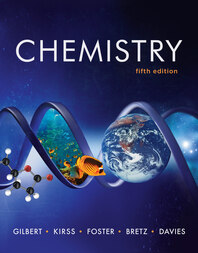
Chemistry
The Science in Context
Fifth Edition
17 January 2017
Territory Rights — Worldwide.
NEW AND UNIQUE MOLECULAR-VISUALISATION PEDAGOGY
New co-author Stacey Lowery Bretz brings innovative molecular-visualisation pedagogy to the text and media. At the beginning of each chapter, Bretz has created a new Particulate Review—a diagnostic about important prior knowledge to interpret particulate images—and Particulate Preview—a short series of questions on a particulate image—that ask students to extend their knowledge about upcoming material in the chapter. At the end of each chapter a new Visual Problem Matrix has been added to the Visual Problems.
INNOVATIVE MEDIA SUPPORTS PROBLEM SOLVING AND VISUAL LEARNING
Smartwork5 offers instructors a sophisticated, user-friendly platform that ties directly to the text's new visualisation pedagogy, including extensive answer-specific feedback and hints. More than 200 new questions are designed to support the new visualisation pedagogy in the text, and 150 tutorial problems offer step-by-step assistance by breaking down problems into manageable parts. The fifth edition features improved ChemTours. Ninety-five tutorial animations have been updated to support lecture, lab and independent student learning.
COAST: A CONSISTENTLY APPLIED, EASY-TO-REMEMBER PROBLEM-SOLVING STRATEGY
Chemistry provides an effective and memorable problem-solving model consistently throughout the book, ancillaries and homework system. Using the acronym COAST (Collect and Organise, Analyse, Solve and Think about it), Chemistry's problem-solving model is introduced in the first chapter and applied in every Sample Exercise, Smartwork5 feedback and every problem in the solutions manual. In the fifth edition, simpler Sample Exercises have combined Collect, Organise and Analyse into one step.
DISTINCT END-OF-CHAPTER PROBLEM-SOLVING SUMMARIES
The Problem-Solving Summary provides a quick reference that includes type of problem, concepts and equations to use, and references to Sample Exercises that model the approach. Students who use the text mostly for problem-solving help can use the Problem Solving Summaries as a guide to the types of problems covered in each chapter.
New co-author Stacey Lowery Bretz brings innovative molecular-visualisation pedagogy to the text and media. At the beginning of each chapter, Bretz has created a new Particulate Review—a diagnostic about important prior knowledge to interpret particulate images—and Particulate Preview—a short series of questions on a particulate image—that ask students to extend their knowledge about upcoming material in the chapter. At the end of each chapter a new Visual Problem Matrix has been added to the Visual Problems.
INNOVATIVE MEDIA SUPPORTS PROBLEM SOLVING AND VISUAL LEARNING
Smartwork5 offers instructors a sophisticated, user-friendly platform that ties directly to the text's new visualisation pedagogy, including extensive answer-specific feedback and hints. More than 200 new questions are designed to support the new visualisation pedagogy in the text, and 150 tutorial problems offer step-by-step assistance by breaking down problems into manageable parts. The fifth edition features improved ChemTours. Ninety-five tutorial animations have been updated to support lecture, lab and independent student learning.
COAST: A CONSISTENTLY APPLIED, EASY-TO-REMEMBER PROBLEM-SOLVING STRATEGY
Chemistry provides an effective and memorable problem-solving model consistently throughout the book, ancillaries and homework system. Using the acronym COAST (Collect and Organise, Analyse, Solve and Think about it), Chemistry's problem-solving model is introduced in the first chapter and applied in every Sample Exercise, Smartwork5 feedback and every problem in the solutions manual. In the fifth edition, simpler Sample Exercises have combined Collect, Organise and Analyse into one step.
DISTINCT END-OF-CHAPTER PROBLEM-SOLVING SUMMARIES
The Problem-Solving Summary provides a quick reference that includes type of problem, concepts and equations to use, and references to Sample Exercises that model the approach. Students who use the text mostly for problem-solving help can use the Problem Solving Summaries as a guide to the types of problems covered in each chapter.


